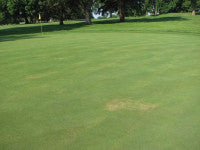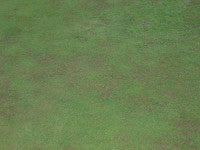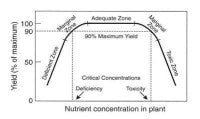What lies beneath?
 Maintaining high performance turfgrass stands is a difficult and sometimes thankless task. Our goal, our aim, is to produce a vigorous turfgrass stand(s) on a continual basis throughout the plant's life. We need to do this both inside and outside the plant's natural growing cycle and, at the same time, we must achieve the growth characteristics and development of the plant we desire in the most economical and practical way.
Maintaining high performance turfgrass stands is a difficult and sometimes thankless task. Our goal, our aim, is to produce a vigorous turfgrass stand(s) on a continual basis throughout the plant's life. We need to do this both inside and outside the plant's natural growing cycle and, at the same time, we must achieve the growth characteristics and development of the plant we desire in the most economical and practical way.
We all understand that nutrients, and their availability, help us manage effectively, aid the development of a grass plant subject to consistent mowing and forced wear and tear and, lastly, control the colour the viewing public expect to see.
Fertilisers and their use are a very important tool for any turfgrass manager. The nutrients within them affect growth cycles, colour, recovery from wear, encourage a dense and uniform grass stand, help develop the extent of rooting we can effectively achieve, can encourage and equally discourage diseases, we could go on.
Fertilisers provide the plant with the essential elements for growth, and each element of the fertilisers we apply throughout the year will affect the use and availability of other elements.
 Back in the 19th Century, Liebig and other scientists discovered that certain elements (N, P, K, Mg etc.) are critical for effective plant growth and development. Now, here is the important bit, 'each element MUST be present in the soil in a specific concentration range for effective plant growth'. If the concentration of any given element in the rootzone is too low, then it will become 'restricted' and a deficiency of that element will exist. Eventually, plant growth will be limited in one form or another. Likewise, if one element in the rootzone is too high then toxicity will occur and plant growth, once again, in one form or another will be limited.
Back in the 19th Century, Liebig and other scientists discovered that certain elements (N, P, K, Mg etc.) are critical for effective plant growth and development. Now, here is the important bit, 'each element MUST be present in the soil in a specific concentration range for effective plant growth'. If the concentration of any given element in the rootzone is too low, then it will become 'restricted' and a deficiency of that element will exist. Eventually, plant growth will be limited in one form or another. Likewise, if one element in the rootzone is too high then toxicity will occur and plant growth, once again, in one form or another will be limited.
At this point, you may be wondering, "why am I continuing to read this?" Well, what I aim to do with this article is to help you identify (by eye and in the field) the signs of nutrient deficiencies that enable you to make informed decisions on future planning that, once again, will encourage a vigorous turfgrass stand.
How can I tell (visually) if I have a problem or not?
Fortunately for us, plants will exhibit or express nutrient deficiency symptoms on their leaves or other plant parts just like they do when disease strikes. The good thing is that we can adjust our style of management to suit what is discovered and quickly fix the problem encountered. The bad thing is that, by the time the deficiency symptoms are expressed, it is too late and some damage will be seen on the plant leaves.
Visually observable symptoms include stunted growth of roots, stems or leaves and chlorosis (yellowing) or necrosis (browning/death) of various organs.
Characteristic symptoms often help us fix the issue with little fuss. Luckily, most of the symptoms we see will be seen on the plant's leaves. Root symptoms cannot be easily seen, unless the plant is very carefully removed from the soil, washed and then studied! For this reason, root symptoms are lesser understood and described by the plant science community.
Expressions of deficiencies
Nitrogen (N) - Soils, especially sand based sports turf soils, are more commonly deficient of nitrogen than any other element. The plant will be light green in colour, lower leaves yellow and drying to a light brown colour. Stunted or slow growth may be seen as N is needed in many essential plant compounds.
Phosphorus (P) - Second to nitrogen, phosphorus is the most often limiting element in soils. The plant will be dark green (in contrast to those lacking N), often developing red and purple colours on the leaf and leaf margins. The plants and seedling plants will often be stunted in growth with maturity of young plants being delayed.
Potassium (K) - After nitrogen and phosphorus, soils are usually most deficient in potassium. As a note, it is because of the importance of these three elements (N P K) that commercial fertilisers list the percentages of these on the bags as a comparison to others.
Sulphur (S) - As enough sulphate is present in most soils, deficiencies of this mineral are quite rare. However, if deficient, the plant will exhibit paling of the older leaves (entire leaf) and tip scorch.
Magnesium (Mg) - Chlorosis of older leaves being the initial symptom but, in this case, you will see interveinal chlorosis (yellowing between the veins or yellow stripes). Mg deficiency is almost never limiting to grass plant development.

Iron (Fe) - Pronounced interveinal chlorosis, similar to Mg, but this time the younger leaves will be affected first. Occasionally, it has been found that, with Fe deficiencies, the veins of the leaf will turn yellow also. In severe cases, the younger leaves will develop necrotic (dead) spots.
Manganese (Mn) - Initial symptoms are similar to that of iron and magnesium, with interveinal chlorosis, but on either the youngest or oldest leaves followed by necrotic spots. When a deficiency of Fe, Mg or Mn is suspected, the best course of action is to use a soil nutrient status test to confirm exactly which element is deficient.
Zinc (Zn) - Leaf margins can be distorted and stunted growth of the plant will be exhibited.
Copper (Cu) - Grasses are rarely deficient in this element as the plant needs so little of it. If there is a deficiency, then the youngest leaves will exhibit a dark green colour and be twisted and/or otherwise misshapen.
Molybdenum (Mo) - Again, quite rare - mid-stem and older leaves develop interveinal chlorosis, progressing to the younger leaves. The youngest leaves may be severely twisted and then die.

Boron (B) - Visual symptoms take a long time to develop as it is slow moving within the plant. Deficiency symptoms develop around the disintegration of internal plant tissue - soil analysis needed to establish levels with this one!
What to do if a deficiency is discovered?
Once the plant has expressed a deficiency via its leaves, or by a stunted growth pattern, the best course of action would be to immediately have the soil tested for nutrient levels. It would be possible to have the sap in the leaf tested, but this would not give any detail on how bad the deficiency is, nor tell us how much of the 'missing' nutrient (quantity) we should apply. So, for purposes of effective management, a soil test is the ideal first course of action.
Of the six major factors affecting the growth of plants (a) Light (b) Mechanical support (c) Heat (d) Air (e) Water and (f) Nutrients only light is not supplied by soils. Soil also supplies the seventeen or so plant nutrients that are essential for plant growth. It makes sense to know what's going on down there!
Phil Sharples, Head Groundsman and Author of The Lawn Guide.
Email: phil.sharples@hotmail.co.uk
